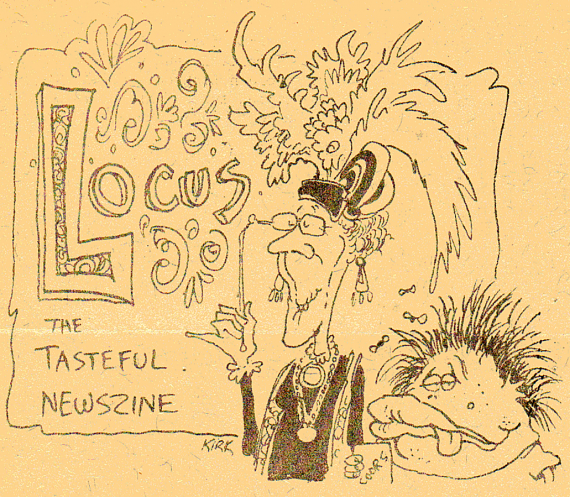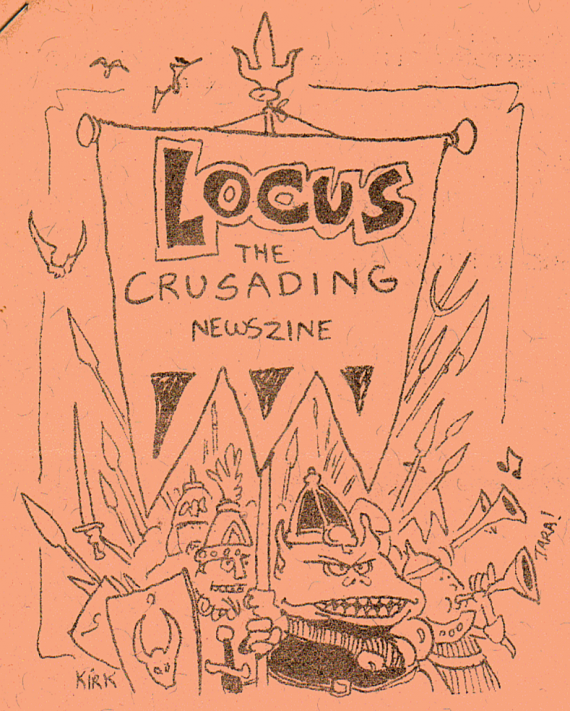Charles N. Brown is no longer with us, but his multiple Hugo Award winning magazine LOCUS, a newszine “covering the science fiction field,” remains the definitive industry trade magazine for the SF&F genre, an absolute must read for authors, editors, publishers, reviewers, and all fen seriously interested in the ongoing state of the industry as it continues to evolve.
Today it is a very slick, professional zine with a formidable online presence, but back in 1968 when it first appeared LOCUS was a traditional fanzine in format, albeit concentrating on news, reviews and interviews reporting on conventions and publications. Thought you might like to read about LOCUS in its infancy.
Alas, the BCSFA/WCSFA archive LOCUS collection is not complete, so I cannot describe the earliest issues. However, I can describe issues 126-136 dating from November 4th 1972 to March 16 1973, a set originally donated to the archive by Spider Robinson.
Then a “bi-weekly newspaper,” LOCUS averaged eight twilltone 8&1/2 by 11 pages (presumably printed on a Gestetner) written, edited and published by Dena and Charles N. Brown out of san Francisco. Ginjer Buchanan was listed as “New York Reporter,” and a rotating cast of volunteers helped with the collation, stapling, labeling and mailing (very much a fannish tradition for most fanzines before the advent of computers). Courier font of course, since the copy was typewritten. The subscription price was $3.00 US for twelve issues, and the mailing cost was an 8 cent stamp.
Here be some highlights:

LOCUS #126 (November 4/1972) offers quite a bit of fannish news. Legendary Irish fan Walt Willis appeals to “Americans who love Ireland” to send him donations for “the fast-growing Alliance party, in which Protestants and Catholics work together for a new Ulster…” and which had little impact on peace prospects at the time, methinks…
The Torcon 2 (Toronto Worldcon) organizers were looking for material to display re the first Torcon in 1948. For example, “Harry Warner says that Les Croutch took movies of the first Torcon. Where are they now?” Ultimately his family donated the footage to the Merril Collection in Toronto I believe, though I suspect after Torcon 2 took place.
And a list of 49 fanzines is provided, including a note that the “twice Hugo runner-up fanzine” ENERGUMEN by Mike and Susan Glickson “will cease publication with #15, and I for one am very sorry to hear that.” This could be the note that triggered the subsequent Hugo victory for ENERGUMEN, to this day the only Canadian fanzine ever to win.
On the pro side we learn UNIVERSE 5 editor Terry Carr is wondering “Doesn’t anybody ever try to write literate sense of wonder stories anymore?” A question some still ask.
James Tiptree Jr. is disappointed ‘his’ suggested titles “Razorblades and Peanut Butter” or “If We Go to the Stars This Morning Where Will We Sleep Tonight?” for an upcoming anthology were rejected by ‘his’ publisher. The anthology, which came out in 1973, was titled TEN THOUSAND LIGHT YEARS FROM HOME at the publisher’s suggestion. Good enough I suppose. Not till 1977 was it revealed James was actually Alice H.B. Sheldon.
A delightful essay by Terry Carr, INSTANT KARMA, describes the LACon (1972 Worldcon) as “a weird convention, as so many of them are. Crowded, fragmented, and constant eddies of tension everywhere. George Clayton fighting with security guards at the door of the masquerade because he didn’t like to wear his name-badge… SFWA itself called a special meeting the last day of the convention and voted to censure the con committee for unspecified heinous acts towards fans and pros (Phil Dick was in the middle of this, and even Lester del Rey got into it). Harlan gave an appalling speech…”

LOCUS 127 (November 17, 1972) announces the first issue of VERTEX, promising articles by such as Bill Rotsler, Gregory Benford, and Ray Bradbury. It also promises “a transcript (compliments of Forry Ackerman) of Robert Heinlein’s 1941 Guest of Honour speech at the Denver world convention. Heinlein had not been pleased when Ackerman published the speech by itself as a fannish monograph in 1942 without informing Heinlein first. One hopes this time around Ackerman asked for Heinlein’s permission.
Speaking of Forry Ackerman, seems to have been a busy lad. In a single paragraph it is reported he gave A. E. van Vogt “the LASFS Forry Award for service to the SF field,” presented Robert Bloch “the Hall of Flame Award for 1972 by Famous Monsters of Filmland magazine, in connection with the opening of his new horror film ASYLUM,” and was himself given “the first Retrospective Evans-Freehafer Award by the LASFS for his part in the 1946 Worldcon.”
“LOCUS LOOKS AT BOOKS – Reviews by Charlie Brown,” features a dozen novels which Brown doesn’t like, including John Brunner’s THE SHEEP LOOK UP, “…useless as propaganda since only those who fully agree with the author will get beyond page 30…” and Gordon Eklund’s A TRACE OF DREAMS, “…another author with a lot of potential, so far unfulfilled.” Brown explains “You may have noticed that I’m much more critical of what I call serious novels… You don’t need a high level of believability for [adventure novels], but a novel which tries to say something serious or tries to present believable characters requires something more. Weak or poor plotting and motivation can be glossed over in a straight action story, but become glaring faults otherwise…”

LOCUS 129 (December 15, 1972) announces “Frederic Wertham’s book on fanzines is titled WORLD OF FANZINES: A SPECIAL FORM OF COMMUNICATION. The book deals with fanzines, not fandom, and will be published next September.” Well, of course, it was Wertham’s 1953 book SEDUCTION OF THE INNOCENT which emasculated the comic book industry, Bill Gaine’s EC COMICS in particular, and led to the introduction of the insipid comics code. Oddly enough, Wertham was quite taken by fanzines and praised them highly in his later book. Go figure.
This time Charlie reviews a bunch of anthologies. He has interesting advice. “When you pick up an anthology and are trying to decide whether to buy it or not, count the number of stories and divide it into the number of pages. If the answer comes out under twenty, put it back. There aren’t that many good short stories in SF and most of the good stories are between 20 and 40 pages. Next, try to read the first story. Most editors know enough to put a very strong story first and, if this one doesn’t impress you, chances are that the rest of the book won’t. Rule number 3 is that most good anthologies are edited by people you’ve heard of. Rule 4 is, of course, that rules one to three are not necessarily true.”
Harry Warner Jr. contributes an interesting essay musing over the upcoming fiftieth anniversary of the March 1923 first issue of WEIRD TALES. He appears to regard it as the first “fannish” prozine, saying “A respectable assemblage of fans would object to any golden anniversary proclamation until three years later, on the theory that science fiction magazines are the real prozines and AMAZING STORIES didn’t start appearing till April 1926… But today, fandom consists of such a complex mixture of the advocates of science fiction, pure fantasy, weird and horror literature that WEIRD TALES might have better claim to embodying the first prozine… probably came closer to symbolizing the total interests of combined fandom than any other prozine…” Debatable I’d say. I’ll stick with AMAZING STORIES as the first true SF prozine. WEIRD TALES was just weird, in my opinion. Wonderfully weird, but not SF.

LOCUS 131 (January 12, 1973) has of interest: “Isaac Asimov was among the authors who protested distribution problems by personally selling autographed copies of their books from pushcarts on Fifth Avenue in New York last month…”
And an odd film note: ““Douglas Trumbull (SILENT RUNNING) will co-direct JOURNEY OF THE OCEANAUTS, the SF story about an undersea journey across the Pacific on foot.” This based on the book by Louis Wolfe, published in 1968, I own a 1970 pocket book version. It’s a juvenile belonging to the “With the towering peak wall to their left and the yawning abyss to their right” school with brief nods to Jules Verne. Oddly, the book is about an Atlantic crossing. I guess Trumbull figured the Pacific would be more exciting. However I remember the book as being rather dull, which may have killed the project. Too difficult to work up a decent script perhaps.

LOCUS 132 (January 26, 1973) reveals Tony Lewis reviewing the short story THE GUY WITH THE EYES in ANALOG, stating “Here we have a new author Spider Robinson with what may prove to be a worthy successor to the White Hart. This is not to say that Robinson is following the technical “shaggy dog” stories of Clarke; but rather has his own humanistic bent. In such stories, plot is somewhat subordinated to characterization. It will be worth your time to read this.” This was Spider’s first SF sale (to editor Ben Bova), and the first Callahan’s Crosstime Saloon tall tale. It initiated a multiple award-winning prolific and popular career. Yea Spider!

LOCUS 136 (March 16, 1973) is most notable for a blurb by Harlan Ellison: “Looks like the BBC/20th Century deal on THE STARLOST has become even bigger. The NBC “prime time access” stations got wind of the project, listened to a twelve minute cassette I cut of me rapping about the series concept, and sent their head-of-unit here to reassure himself with a meeting with me and [Douglas] Trumbull, that they wanted it for syndication this September… this without a script, a pilot, a star-studded “package”… just on the strength of an Ellison idea. So you’ll see THE STARLOST sooner than any of us thought.”
Ah, hmmm. Ellison is indeed the creator of THE STARLOST concept, an epic series involving a generational starship freighting sixty domes, each with its own culture and habitat, each being its own little universe which star Keir Dullea (and others) explore episode by episode. BBC rejected the concept, but Twentieth Century made a deal with Canada’s CTV network to produce the series in Toronto. Ben Bova was hired as science consultant.
Alas, creative differences between Harlan and CTV defeated Harlan’s vision. Worse, Trumbull’s proposed Magicam process which would have seamlessly inserted the actors into miniature sets and incredible landscapes—each dome fifty miles in width—failed to work in time, forcing CTV to retreat to standard blue screen techniques on primitive two-inch videotape which were visually paltry in comparison. Not to mention I remember being bored stiff watching the mere 16 episodes produced.
What a missed opportunity. THE STARLOST could have been utterly fantastic, truly groundbreaking, but turned out to be disappointingly different from what Harlan originally envisioned. Consequently he insisted his name be taken off the credits and replaced with “Cordwainer Bird.” Full marks for effort though. Could have been greater and better than the earlier STAR TREK series… if only…
Note: Ben Bova’s fictionalized account, his novel STARCROSSED, remains a highly readable and amusing version of his experience with THE STARLOST.
Also note: all of the issues described above the LOCUS cover page was solid text except for the upper left hand corner which figured logos created by well-known fan artists of the era. The six examples presented for your pleasure were drawn by:
Helmet Pesch – Illo #1 (issue 126)
Jim Mcleod – Illo #2 (issue 127)
Tim Kirk – illos #3 & 4 (issues 129, & 131)
Grant Canfield – illos # 5 & 6 (issues #132 & 136)
P.S. At some point in the future I will describe early issues of Andy Porter’s competing tradezine SF CHRONICLE.
P.P.S. Today is my 63rd birthday. Expect a future article on what it’s like to be a living fossil.










